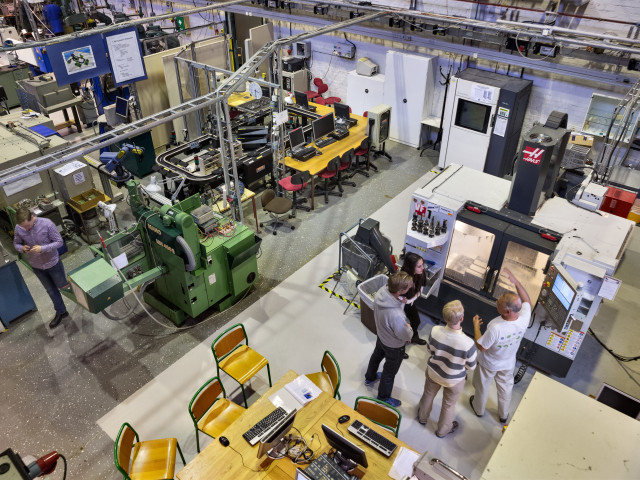The course is given entirely remotely with teacher-led meetings on-line in the form of a two-hour seminar per week during work-hours. Attendance at the seminar lectures and active participation in discussions of these as well as of the video- and written material studied before the seminars is required. The video material includes, for example, demonstrations of apps and instruments as well as films for applying the RAMP I tool. In addition to the seminars, the course includes literature studies and four assignments.
CH209V RAMP Course 1: Assessment of Work-Related Injury Risks using RAMP I 2.5 credits

In RAMP Course 1: Assessment of Work-Related Injury Risks using RAMP I, you get an overview of the entire RAMP tool and you learn to identify and assess musculoskeletal (MSD) risks using the first module in the RAMP tool (RAMP I). Click here to register to RAMP Course 1.
The course starts the 30/8 3 - 5 p.m.
Information per course offering
Information for Autumn 2024 Start 26 Aug 2024 single courses students
- Course location
KTH Flemingsberg
- Duration
- 26 Aug 2024 - 4 Oct 2024
- Periods
- P1 (2.5 hp)
- Pace of study
25%
- Application code
10062
- Form of study
Distance Daytime
- Language of instruction
Swedish
- Course memo
- Course memo is not published
- Number of places
10 - 100
- Target group
- No information inserted
- Planned modular schedule
- [object Object]
- Schedule
- Schedule is not published
- Part of programme
- No information inserted
Please note that Students not located in Sweden may have problems attending a course at KTH.
You could meet obstacles if you're required to pay fees or if you do not have a Swedish Mobile BankID.
Contact
Caroline Ingeborg Jegerschöld (cije@kth.se)
Course syllabus as PDF
Please note: all information from the Course syllabus is available on this page in an accessible format.
Course syllabus CH209V (Autumn 2024–)Content and learning outcomes
Course disposition
Course contents
In the course "Risk assessment of work-related injuries with RAMP I," the student receives an overview of the entire RAMP tool and learns to identify and assess musculoskeletal disorder (MSD) risks using the first module of the RAMP tool (RAMP I).
The course content is given in different modules with a focus on:
- Musculoskeletal injuries,
- The RAMP I tool,
- Assessment and examples from the food industry,
- Assessment and examples from the logistics industry,
- Discussions and reflections, including a research article
The course is given remotely.
In the course seminars and for the assignments, the course language is Swedish. Some of the course material, including videos and self-correcting tasks, is in English.
Intended learning outcomes
In this, the first RAMP course, the overall objectives are that the student acquires an overview of the risk management tool RAMP and how each of the four modules in the RAMP tool should be applied. In addition, the objective is that the student gets hands-on training in carrying out risk assessments with the RAMP I module and learns how to interpret the results, as well as how to proceed in the risk management process.
After successful completion of this course the student shall:
- have acquired and be able to articulate basic knowledge of musculoskeletal disorder (MSD) risk factors, a selection of MSD risk assessment methods, and injuries related to manual handling and their consequences for individuals, organisations and society
- be able to identify MSD risk factors in manual handling at the workplace
- be able to perform MSD risk assessments using RAMP I
- be familiar with how to interpret the assessment results and develop risk-reducing solutions and action plans (using RAMP Results and Action modules)
- be able to make informed decisions on how to proceed with the risk management process when MSD risk factors have been identified
Literature and preparations
Specific prerequisites
120 credits in technical science, natural science or medical science. Alternatively, at least 2 years of professional experience in work environment development. English B/6
Equipment
Seminars are given via Zoom. All communication between student and teacher and between students takes place via a learning platform, which is why the student is expected to have access to a computer and the internet.
Literature
Examination and completion
If the course is discontinued, students may request to be examined during the following two academic years.
Grading scale
Examination
- INL1 - Hand in assignment, 0.5 credits, grading scale: P, F
- SEM1 - Seminars, 0.5 credits, grading scale: P, F
- ÖVN1 - Exercises, 1.5 credits, grading scale: P, F
Based on recommendation from KTH’s coordinator for disabilities, the examiner will decide how to adapt an examination for students with documented disability.
The examiner may apply another examination format when re-examining individual students.
Based on recommendation from KTH’s coordinator for disabilities, the examiner will decide how to adapt an examination for students with documented disability.
The examiner may apply another examination format when re-examining individual students.
Learning objective 1 is examined through ÖVN1, INL1 and SEM1.
Learning objective 2 is examined through ÖVN1 and SEM1.
Learning objective 3 is examined through ÖVN1.
Learning objective 4 is examined through ÖVN1 and SEM1.
Learning objective 5 is examined through ÖVN1, SEM1 and INL1
Opportunity to complete the requirements via supplementary examination
Opportunity to raise an approved grade via renewed examination
Examiner
Ethical approach
- All members of a group are responsible for the group's work.
- In any assessment, every student shall honestly disclose any help received and sources used.
- In an oral assessment, every student shall be able to present and answer questions about the entire assignment and solution.
Further information
Course room in Canvas
Offered by
Main field of study
Education cycle
Add-on studies
The three life-long learning courses CH209V, CH210V och CH211V. are provided consecutively.
Contact
Supplementary information
The target group for this course are persons who are not program students at KTH.